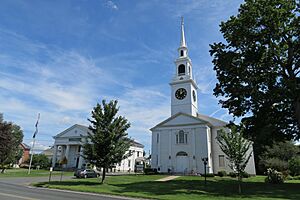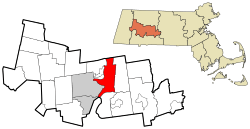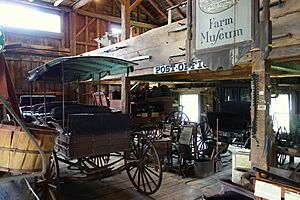Hadley, Massachusetts facts for kids
Quick facts for kids
Hadley, Massachusetts
|
||
|---|---|---|

Town Hall and First Congregational Church
|
||
|
||
| Nicknames:
"The Breadbasket of Massachusetts"
"Asparagus Capital of the World" |
||

Location in Hampshire County in Massachusetts
|
||
| Country | United States | |
| State | Massachusetts | |
| County | Hampshire | |
| Settled | 1659 | |
| Incorporated | May 22, 1661 | |
| Government | ||
| • Type | Open town meeting | |
| Area | ||
| • Total | 24.6 sq mi (63.7 km2) | |
| • Land | 23.1 sq mi (59.8 km2) | |
| • Water | 1.5 sq mi (3.9 km2) | |
| Elevation | 129 ft (39 m) | |
| Population
(2020)
|
||
| • Total | 5,325 | |
| • Density | 216.51/sq mi (83.59/km2) | |
| Time zone | UTC−5 (Eastern) | |
| • Summer (DST) | UTC−4 (Eastern) | |
| ZIP Code |
01035
|
|
| Area code(s) | 413 | |
| FIPS code | 25-27690 | |
| GNIS feature ID | 0618201 | |
Hadley (pronounced HAD-lee) is a historic town in Hampshire County, Massachusetts, United States. It's known as a "New England town." In 2020, about 5,325 people lived there. Hadley is part of the larger Springfield area.
The town is a popular shopping spot. Many people visit the Hampshire Mall and Mountain Farms Mall. These malls are located along Route 9, a main road that runs through Hadley.
Contents
History of Hadley
Early Beginnings
Hadley was first settled by Europeans in 1659. It officially became a town in 1661. The town was named after Hadleigh, a place in England.
The first settlers were families from other Connecticut colonies. They wanted to start a new community because of disagreements about their church. John Russell led this group.
Nathaniel Dickinson was the first settler to survey the streets. He helped plan what are now Hadley, Hatfield, and Amherst. Hadley used to be much larger. Over time, parts of it became separate towns like Hatfield, Amherst, South Hadley, Granby, and Belchertown.
Hidden Generals and Witchcraft Tales
Two English generals, Edward Whalley and William Goffe, hid in Hadley. They were wanted for their role in the execution of King Charles I of England. The town's minister, John Russell, kept them safe.
During King Philip's War, Native Americans attacked Hadley. Some stories say General Goffe helped the town defend itself. Because the townspeople kept Goffe's secret, a legend grew. It's called the "Angel of Hadley" and is part of the town's history.
In 1683, before the famous Salem witch trials, a woman named Mary Webster was accused of witchcraft in Hadley. She was found not guilty. However, some angry townspeople tried to hang her, but they failed.
Famous Residents
Several important people have lived in Hadley. Joseph Hooker, a general during the Civil War, lived here for a long time.
Levi Stockbridge was another notable resident. He was a farmer and helped start the Massachusetts Agricultural College. This college is now known as the University of Massachusetts Amherst.
Modern Hadley: Farms and Stores
In the 1960s, Hadley began to change. The nearby University of Massachusetts Amherst grew a lot. This led to more houses being built on former farmland.
Route 9 became a busy area for businesses. Large stores like Stop & Shop and McDonald's opened. Today, Hadley's economy mixes farming with big stores and the Hampshire Mall.
New stores like Wal-Mart, Home Depot, and Lowe's have been planned. Some residents were upset because these projects would affect farmland. In 2003, a group called Hadley Neighbors for Sensible Development formed. They opposed large commercial growth.
However, many locals supported the new stores. They felt it would save them money. In 2008, Wal-Mart stopped its plans due to rules about wetlands. The developer has continued to fight this decision.
In 2010, the Massachusetts Department of Environmental Protection found that Lowe's had illegally filled wetlands. They fined the developer.
The World Monuments Fund added Hadley's "Cultural Landscape" to its 2010 list of endangered sites. This means Hadley's unique open-field farming landscape is important to protect. This type of farming was common in early New England but is rare today.
Economy
Hadley's economy relies on two main things: farming and retail. Massachusetts Route 9 has many stores, making it a retail hub. The area also has rich soil, called Hadley loam, which is great for farming.
One of Hadley's most important crops for centuries has been asparagus. It's so famous that it's sometimes called "Hadley grass." Hadley asparagus is known for its quality. It has even been served in fancy restaurants in France and Germany, and at Queen Elizabeth II's spring feast in England!
Education
Hadley has excellent schools for its young residents.
- Hadley Elementary School serves students from kindergarten through sixth grade.
- Hopkins Academy is for students in grades seven through twelve. It was founded in 1664 with money from Edward Hopkins, a rich merchant. Hopkins Academy is the fourth oldest public high school in the United States!
- The Pioneer Valley Chinese Immersion Charter School is also located in Hadley.
Geography
Hadley covers about 63.7 square kilometers (24.6 square miles). Most of this is land, with some water.
Hadley is bordered by several towns:
- Hatfield to the northwest
- Sunderland to the north
- Amherst to the east
- South Hadley to the south
- Northampton to the west, across the Connecticut River.
The Mount Holyoke Range forms the border with South Hadley. The highest point in Hadley is on Mount Hitchcock, which is about 300 meters (990 to 1000 feet) high. The Metacomet-Monadnock Trail runs along the Holyoke Range, offering amazing views.
Climate
Hadley, Massachusetts, experiences a typical New England climate.
- Temperatures are below 10 degrees Celsius (50 degrees Fahrenheit) for about 205 days each year.
- The town gets about 113.5 centimeters (44.7 inches) of rain each year. This is a lot compared to other parts of the U.S.
- Snow covers the ground for about 66 days a year.
- The air humidity is below 60% for about 18 days a year.
Population and People
| Historical population | ||
|---|---|---|
| Year | Pop. | ±% |
| 1850 | 1,986 | — |
| 1860 | 2,105 | +6.0% |
| 1870 | 2,301 | +9.3% |
| 1880 | 1,938 | −15.8% |
| 1890 | 1,669 | −13.9% |
| 1900 | 1,789 | +7.2% |
| 1910 | 1,999 | +11.7% |
| 1920 | 2,784 | +39.3% |
| 1930 | 2,082 | −25.2% |
| 1940 | 2,576 | +23.7% |
| 1950 | 2,639 | +2.4% |
| 1960 | 3,099 | +17.4% |
| 1970 | 3,750 | +21.0% |
| 1980 | 4,125 | +10.0% |
| 1990 | 4,231 | +2.6% |
| 2000 | 4,793 | +13.3% |
| 2010 | 5,250 | +9.5% |
| 2020 | 5,325 | +1.4% |
| 2022* | 5,270 | −1.0% |
| * = population estimate. | ||
In 2000, Hadley had 4,793 people living there. There were 1,895 households, with 1,248 being families.
- About 26.6% of households had children under 18.
- 53.1% were married couples.
- The average household had 2.45 people.
The population was spread out by age:
- 20.0% were under 18.
- 7.0% were 18 to 24.
- 27.7% were 25 to 44.
- 25.7% were 45 to 64.
- 19.5% were 65 or older.
The average age in Hadley was 42 years old.
Fun Places to Visit in Hadley
- Porter-Phelps-Huntington Museum: A historic house museum.
- Skinner State Park and Historic Summit House: A park with great views from the top.
- Hopkins Academy: The fourth oldest school in the U.S., still serving as Hadley's middle and high school.
- Hadley Farm Museum: Learn about Hadley's farming past.
- Hadley Town Common: A central green space in the town.
- Regicides monument: This monument marks where Rev. John Russell hid the English generals Edward Whalley and William Goffe.
- Warren McGuirk Alumni Stadium: The football stadium for the University of Massachusetts Amherst.
- Norwottuck Branch Rail Trail: A bike path that goes through Hadley, connecting Northampton to Belchertown.
- Connecticut River: The longest river in New England.
- Silvio O. Conte National Fish and Wildlife Refuge: A special wildlife refuge that protects an entire river system. The Fort River Birding and Nature Trail in Hadley is a 1.1-mile accessible loop perfect for walking and enjoying nature.
Notable People from Hadley
Many interesting people have connections to Hadley:
- William Goffe: An English parliamentarian who hid in Hadley.
- Lisa Green: A distinguished professor of Linguistics at the University of Massachusetts Amherst.
- Thomas Hannum: A band director at UMass Amherst and a member of the Drum Corps International Hall of Fame.
- Joseph Hooker: A famous general from the American Civil War.
- Clifton Johnson: An American writer, illustrator, and photographer.
- Elizabeth Porter Phelps: An early American diarist.
- Levi Stockbridge: A farmer and scientist who helped found the University of Massachusetts Amherst.
- John Webster: A former governor of the Colony of Connecticut and a founder of Hadley.
- Edward Whalley: An English parliamentarian who also hid in Hadley.
See also
 In Spanish: Hadley (Massachusetts) para niños
In Spanish: Hadley (Massachusetts) para niños



